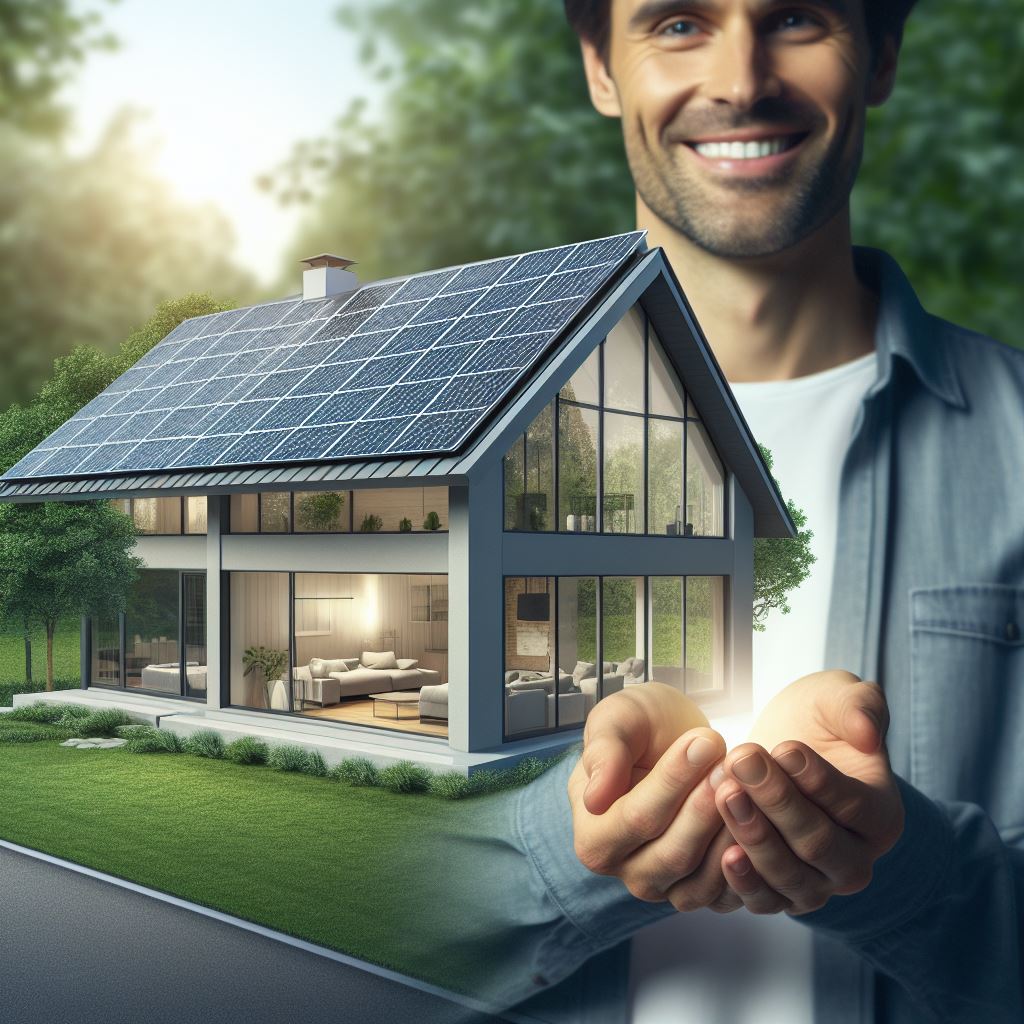Introduction
The future of suburban homes is a topic that never ceases to captivate.
Suburban living has long been a fundamental part of the American dream, synonymous with comfort, space, and a close-knit community.
However, as we approach 2024, it is essential to explore the potential changes that suburban homes may undergo.
Understanding the trends that will shape the future of these homes is critical for homeowners, real estate developers, and investors alike.
By examining these trends, one can gain insight into future demands, technology advancements, and evolving lifestyle preferences.
This knowledge will enable homeowners and investors to make informed decisions and adapt their properties accordingly.
The possibilities for the future of suburban homes are vast and exciting.
We may witness the integration of cutting-edge technologies, such as smart home systems and energy-efficient solutions, becoming commonplace.
Home automation may revolutionize how we interact with our surroundings, making everyday tasks more convenient and streamlined.
Additionally, the design and layout of suburban homes might undergo significant changes.
With the increasing focus on sustainability and eco-friendly practices, we may see the emergence of green spaces within suburban communities.
Landscaping could be transformed into sustainable gardens, rainwater harvesting systems might become prevalent, and solar panels could be integrated seamlessly into the architecture.
In essence, the future of suburban homes holds immense potential for innovation and transformation.
By discussing the trends that will shape 2024, we can prepare ourselves for the changes that lie ahead.
So, join us as we delve into the fascinating world of suburban homes and explore the exciting possibilities that await in the near future.
Current State of Suburban Homes
Characteristics and Features commonly found in suburban homes today
- Spacious interiors with multiple bedrooms and bathrooms for accommodating families.
- Well-equipped kitchens with modern appliances and ample storage space.
- Open floor plans that promote a sense of connectivity and allow for easy movement.
- Private outdoor spaces such as gardens, yards, and patios for relaxation and recreation.
- Attached garages or ample parking spaces for vehicles.
- Energy-efficient features like insulated windows, solar panels, and energy-saving appliances.
- Traditional architectural styles like Colonial, Victorian, or Ranch, depending on the region.
- Home security systems to ensure safety and peace of mind.
- Accessibility features like ramps and wide doorways for elderly or disabled individuals.
- Various storage solutions such as walk-in closets, attic space, and built-in cabinets.
Ongoing trends or preferences in suburban home design and amenities
- Integration of smart home technology for increased convenience and energy efficiency.
- Multi-functional spaces that can adapt to changing needs, such as home offices or gym areas.
- Sustainable and eco-friendly building materials, like reclaimed wood or recycled countertops.
- Emphasis on natural light through large windows or skylights for a brighter and more inviting atmosphere.
- Outdoor living spaces with fire pits, outdoor kitchens, and entertainment areas for social gatherings.
- Enhanced home automation systems, including voice-activated assistants and integrated security features.
- Energy-efficient heating, ventilation, and air conditioning (HVAC) systems for reduced energy consumption.
- Home theaters or media rooms for immersive entertainment experiences.
- Designated storage areas for package delivery and secure online shopping.
- Home offices equipped with advanced technology and ergonomically designed furniture to support remote work.
Demographic factors influencing the demand for suburban homes
- Growing preference for suburban living among millennials seeking more space and a quieter lifestyle.
- The aging population’s desire for single-level homes and communities that offer adequate healthcare facilities.
- Families with children opting for suburban neighborhoods with reputable schools and safer environments.
- An increase in remote work opportunities, allowing individuals to relocate to suburban areas while maintaining professional commitments.
- Affordability compared to urban areas, where housing prices often tend to be higher.
- Proximity to nature and recreational amenities, appealing to outdoor enthusiasts and active lifestyles.
- Availability of larger lots and greener surroundings, providing a sense of privacy and tranquility.
In fact, suburban homes today showcase desirable features such as spaciousness, modern amenities, and energy-efficient designs.
Ongoing trends emphasize smart technology, sustainable materials, and multi-functional spaces.
Demographic factors like the preferences of millennials, the aging population, and families with children heavily influence the demand for suburban homes.
With the future ahead, these trends and factors will further shape the suburban housing landscape in the coming years.
Read: Tech Advances Shaping Real Estate in 2024
Technological Advancements Shaping Suburban Homes
Impact of smart home technology on suburban homes
Smart home technology has revolutionized the way we interact with our homes, making them more efficient and convenient.
With the rise of Internet of Things (IoT) devices, suburban homes have become smarter than ever before.
- Energy Efficiency: Smart home technology allows homeowners to monitor and control their energy consumption more effectively.
By connecting appliances, lighting, and heating systems to a centralized hub, residents can optimize energy usage, saving both money and the environment. - Home Security: Suburban homes can now benefit from advanced security features such as smart door locks, surveillance cameras, and motion sensors.
With real-time notifications and remote monitoring, homeowners can ensure the safety of their property even when they are away. - Appliance Automation: Gone are the days of manually operating household appliances.
Smart devices, like intelligent thermostats, refrigerators, and washing machines, can now be controlled remotely or programmed to perform specific tasks automatically.
This integration saves time and creates a more convenient lifestyle.
Integration of artificial intelligence in home automation systems
Artificial intelligence (AI) has made its way into home automation systems, enhancing functionality and making them more intelligent.
AI-powered assistants, such as Amazon Alexa and Google Assistant, are now commonplace in suburban homes, providing a seamless user experience.
- Voice Control: AI assistants enable homeowners to control various smart devices using voice commands.
From adjusting the temperature to playing music, AI technology offers unparalleled convenience, making day-to-day tasks effortless. - Personalized Experiences: By analyzing user behavior and preferences, AI can tailor the home environment to meet individual needs.
Smart thermostats can learn temperature preferences, while AI lighting systems can adapt to specific moods, creating a personalized ambiance. - Predictive Maintenance: AI algorithms can monitor the health of appliances and systems in real-time, predicting and preventing potential failures.
This proactive approach reduces maintenance costs and minimizes inconvenience for suburban homeowners.
Potential benefits and challenges of incorporating advanced technologies
While technological advancements bring numerous benefits to suburban homes, they also present challenges that need to be addressed.
- Benefits: Advanced technologies enhance comfort, convenience, and overall quality of life in suburban homes.
Energy savings, improved security, and personalized experiences are just a few of the advantages that make these advancements worth adopting. - Challenges: Increased reliance on technology raises concerns about privacy and cybersecurity.
As more devices become interconnected, the risk of hacking and data breaches becomes a significant challenge.
Adequate security measures and user education are crucial to mitigate these risks. - Cost: Implementing advanced technologies in suburban homes can be expensive upfront.
However, the long-term benefits, such as energy savings and increased home value, often outweigh the initial investment.
Government incentives and decreasing costs can also make these technologies more accessible in the future.
In short, technological advancements have transformed suburban homes into smart and efficient living spaces.
Smart home technology and artificial intelligence offer numerous benefits such as energy efficiency, enhanced security, and personalized experiences.
While challenges like privacy and cost exist, the future of suburban homes is undoubtedly shaped by these advanced technologies.
Homeowners should embrace these innovations to create a more comfortable and sustainable living environment.
Read: 2024’s Hot Real Estate Markets: Top 5 Cities
Sustainability and Energy Efficiency
Importance of sustainability in home design and construction
- Incorporating sustainable practices in home design and construction is becoming increasingly crucial.
- Homeowners are now understanding the importance of sustainable materials and techniques.
- Sustainable homes reduce negative environmental impact and promote energy efficiency.
- Sustainable design can include features like solar panels, rainwater harvesting, and efficient insulation.
- The use of eco-friendly materials, such as bamboo flooring and recycled countertops, is on the rise.
- Builders and architects are embracing sustainable practices to meet the demand for environmentally conscious homes.
- Energy-efficient appliances and smart home technologies play a significant role in sustainable homes.
- Sustainable homes prioritize natural lighting, ventilation, and green spaces for improved quality of life.
Trends in energy-efficient features and renewable energy sources for suburban homes
- Energy-efficient features like LED lighting and programmable thermostats are on the rise.
- High-efficiency heating and cooling systems help reduce energy consumption and lower utility bills.
- Smart home technologies allow homeowners to monitor and control energy usage remotely.
- Suburban homes are increasingly utilizing renewable energy sources such as solar power.
- Solar panels are becoming more affordable and efficient, making them an attractive option for homeowners.
- Home battery storage systems allow for the storage of excess solar energy for later use.
- Geothermal heating and cooling systems tap into the earth’s natural heat for energy-efficient temperature control.
- Suburban homes are incorporating energy-efficient windows and insulation to reduce heat loss.
Potential long-term cost savings and environmental benefits of sustainable suburban homes
- Sustainable suburban homes offer significant long-term cost savings for homeowners.
- Energy-efficient features and renewable energy sources reduce utility bills over time.
- Homeowners can take advantage of government incentives and tax credits for sustainable home improvements.
- Sustainable homes have a smaller carbon footprint and contribute less to climate change.
- Reduced reliance on fossil fuels and utility grids decreases environmental impact.
- Sustainable homes often have better indoor air quality, promoting overall health and well-being.
- Green spaces and environmentally friendly landscaping enhance the aesthetics and value of suburban homes.
- Building sustainable suburban homes sets a positive example for future generations and promotes eco-conscious living.
In general, sustainability and energy efficiency are increasingly important in the design and construction of suburban homes.
Homeowners are recognizing the benefits of sustainable features, such as renewable energy sources and energy-efficient appliances.
These homes not only offer long-term cost savings but also reduce the environmental impact.
By embracing sustainability, suburban homes can become more environmentally friendly, healthier, and aesthetically pleasing.
Read: Interest Rate Impact on 2024 Property Market

Evolving Home Designs and Floor Plans
Emerging trends in suburban home design, such as open-concept layouts and flexible spaces
In the not-too-distant future of 2024, suburban home designs are experiencing a significant transformation.
Traditional floor plans are being tossed aside in favor of open-concept layouts that offer a sense of spaciousness and connectivity.
Walls are no longer seen as barriers but rather as opportunities to create flexible spaces that can adapt to different needs.
The shift towards open-concept designs is driven by the desire for a more social and interactive living experience.
These layouts provide a seamless flow between the living room, dining area, and kitchen, making it easier for family members to connect and engage with one another.
Whether it’s hosting a dinner party or simply keeping an eye on the kids while cooking, open-concept layouts are versatile and accommodating.
Gone are the days of separate rooms designated for specific purposes.
Homeowners are now seeking adaptable spaces that can be easily transformed to suit their changing needs.
This might mean having a room that serves as a home office during the day and a yoga studio or playroom in the evenings.
The possibilities are endless, and these flexible spaces allow homeowners to maximize every square inch of their suburban homes.
Potential rise of multi-generational living arrangements and the need for adaptable floor plans
Another emerging trend in suburban home design is the potential rise of multi-generational living arrangements.
With the increasing cost of living and the desire to support and stay close to family members, more households are considering the option of multiple generations living under one roof.
This has led to a growing need for adaptable floor plans that can comfortably accommodate different family units.
Adaptable floor plans come into play by offering separate living spaces within a home that still maintain a sense of togetherness.
This means having designated areas that provide privacy and personal space for each generation, while also including shared spaces for family bonding and gatherings.
With the right floor plan, multi-generational living can be a harmonious and fulfilling experience.
Importance of outdoor spaces and their integration into suburban home designs
In this future vision of suburban homes, the importance of outdoor spaces cannot be overstated.
Homeowners are realizing the value of having access to nature and fresh air right at their doorstep.
As a result, suburban home designs are embracing outdoor living like never before.
Outdoor spaces are being seamlessly integrated into the overall design of suburban homes.
Patios, decks, or even rooftop gardens are becoming a natural extension of the indoor living areas.
Homeowners are creating inviting outdoor lounges, dining areas, and even outdoor kitchens for entertaining friends and family.
These outdoor spaces offer a retreat from the demands of daily life and provide opportunities for relaxation and rejuvenation.
Furthermore, the pandemic has emphasized the need for private and safe outdoor spaces.
Homeowners are seeking solace in their own yards, creating lush gardens, and adding features like fire pits or hot tubs.
The potential for outdoor entertainment and leisure has never been more important in suburban homes.
In review, the future of suburban homes in 2024 promises to be a blend of function and style.
Open-concept layouts and flexible spaces will enable homeowners to adapt their homes to their changing lifestyles.
The rise of multi-generational living arrangements will call for adaptable floor plans that cater to the needs of different generations.
Finally, the integration of outdoor spaces will provide homeowners with a sanctuary right in their own backyards.
This evolution in home design and floor plans will undoubtedly enhance the suburban living experience for years to come.
Read: Millennial Home Buying Trends in 2024
Changing Community Dynamics and Amenities
Potential impact of remote work on suburban neighborhoods and community services
Remote work has the potential to reshape traditional suburban neighborhoods and their community dynamics.
With more individuals working from home, the need for commuting decreases, altering the social fabric.
Suburban neighborhoods could transform into vibrant communities with increased social interactions during daytime hours.
Community centers might experience higher usage rates during weekdays, offering a space to collaborate and network.
Remote work can lead to increased demand for flexible childcare services and programs within suburban communities.
As more professionals work remotely, local businesses could benefit from increased daytime foot traffic.
Demand for shared spaces and amenities in suburban developments
The demand for shared spaces and amenities in suburban developments is on the rise.
Developers are recognizing the importance of creating shared spaces that foster community engagement.
Shared amenities such as parks, sports fields, and community gardens enhance the quality of life within suburban neighborhoods.
Co-working spaces within suburban developments provide opportunities for collaboration and networking.
Shared amenities can also include fitness centers, swimming pools, and recreational facilities for residents’ enjoyment.
The inclusion of shared spaces and amenities can attract a diverse range of residents and enhance community bonding.
Importance of creating vibrant and inclusive suburban communities
Suburban communities can benefit from vibrant and inclusive environments that foster a sense of belonging.
Incorporating a mix of housing options in suburban developments accommodates residents from various socioeconomic backgrounds.
Creating walkable neighborhoods with amenities accessible to all residents promotes inclusivity.
Planning for diverse community events and activities encourages social participation and interaction.
Inclusive suburban communities should prioritize accessibility for individuals with disabilities, ensuring equal opportunities for all.
By embracing cultural diversity and promoting acceptance, suburban neighborhoods can cultivate a sense of unity and belonging.
In a nutshell, the future of suburban homes in 2024 will witness changing community dynamics and an increased demand for shared spaces and amenities.
The rise of remote work will impact suburban neighborhoods, transforming them into vibrant hubs of daytime activity.
Developers must recognize the significance of shared spaces and amenities, catering to the evolving needs and desires of residents.
Vibrant and inclusive suburban communities can be created by incorporating diverse housing options, designing walkable neighborhoods, and fostering social interactions through community events.
The future of suburban living lies in creating engaging and inclusive environments that prioritize the well-being and satisfaction of its residents.
Regulatory and Policy Considerations
Potential Changes in Zoning or Building Regulations
Local governments may implement relaxed zoning regulations to accommodate mixed-use developments in suburban areas.
Building codes might be modified to encourage the use of eco-friendly materials and energy-efficient designs.
Height restrictions could be lifted to allow for the construction of taller buildings and denser housing options.
New regulations may be introduced to promote the incorporation of smart home technology and infrastructure in suburban homes.
Zoning laws might be revised to incentivize the construction of accessory dwelling units (ADUs) or granny flats.
Importance of Affordability and Housing Accessibility
Affordable housing initiatives should be prioritized to ensure that suburban communities remain diverse and accessible.
Developers should explore creative financing options like shared-equity models to increase affordability in suburban areas.
Public-private partnerships can help in providing affordable housing opportunities while also fostering community development.
Proactive steps should be taken to address the issue of housing shortages and high property prices in suburban regions.
Ensuring a range of housing options, including rental units, is vital to cater to different income groups in suburban areas.
Initiatives and Incentives for Sustainable and Inclusive Suburban Housing
Government incentives, such as tax breaks, can be offered to developers who incorporate green building practices in suburban projects.
Encouraging the development of green spaces, parks, and community gardens can enhance the quality of life in suburban settings.
Promoting transit-oriented development can reduce reliance on cars and create more walkable and sustainable suburban neighborhoods.
Implementing inclusionary housing policies can ensure that a certain percentage of suburban homes are designated as affordable.
Providing access to essential amenities like healthcare facilities and schools is crucial for creating inclusive suburban communities.
Basically, there are several regulatory and policy considerations that may influence the future of suburban homes.
Changes in zoning and building regulations can create more diverse and sustainable suburban communities.
Ensuring affordability and housing accessibility is of utmost importance to maintain a healthy housing market.
Additionally, initiatives and incentives that promote sustainability and inclusivity can contribute to the overall well-being of suburban areas.
By addressing these considerations, we can shape a future where suburban homes are not only visually appealing but also affordable, accessible, and sustainable for all.
Conclusion
In summary, by 2024, suburban homes are expected to show key trends and changes.
These include the integration of smart technology, sustainable and eco-friendly features, and flexible living spaces.
Envision the potential benefits and opportunities presented by these trends, such as increased energy efficiency, improved quality of life, and enhanced convenience.
To further explore and discuss the future of suburban homes, engage in conversations and research on topics like smart cities, innovative construction materials, and community development.
Remember, suburban homes of the future have the potential to revolutionize the way we live, work, and interact in our neighborhoods.
Let your imagination run wild as we shape the future together.




